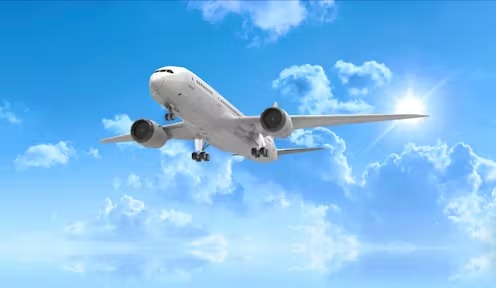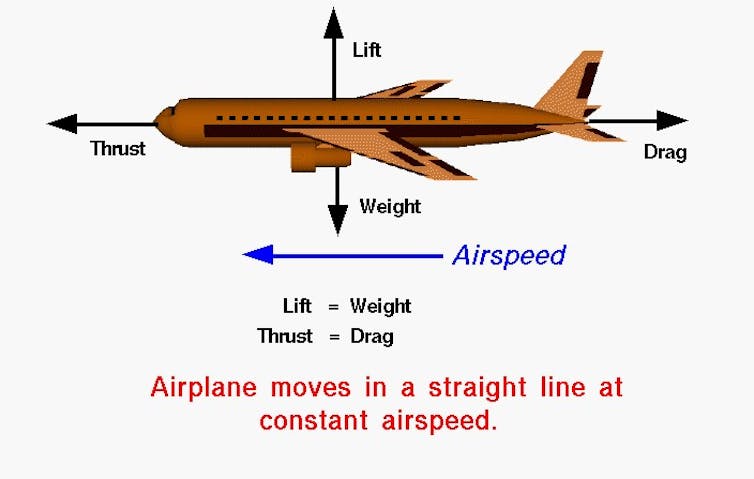Airplane flight is one of the most significant technological achievements of the 20th century. The invention of the airplane allows people to travel from one side of the planet to the other in less than a day, compared with weeks of travel by boat and train.
Understanding precisely why airplanes fly is an ongoing challenge for aerospace engineers, like me, who study and design airplanes, rockets, satellites, helicopters and space capsules.
Our job is to make sure that flying through the air or in space is safe and reliable, by using tools and ideas from science and mathematics, like computer simulations and experiments.
Because of that work, flying in an airplane is the safest way to travel – safer than cars, buses, trains or boats. But although aerospace engineers design aircraft that are stunningly sophisticated, you might be surprised to learn there are still some details about the physics of flight that we don’t fully understand.
The forces of weight, thrust, drag and lift act on a plane to keep it aloft and moving. NASA
May the force(s) be with you
There are four forces that aerospace engineers consider when designing an airplane: weight, thrust, drag and lift. Engineers use these forces to help design the shape of the airplane, the size of the wings, and figure out how many passengers the airplane can carry.
For example, when an airplane takes off, the thrust must be greater than the drag, and the lift must be greater than the weight. If you watch an airplane take off, you’ll see the wings change shape using flaps from the back of the wings. The flaps help make more lift, but they also make more drag, so a powerful engine is necessary to create more thrust.
When the airplane is high enough and is cruising to your destination, lift needs to balance the weight, and the thrust needs to balance the drag. So the pilot pulls the flaps in and can set the engine to produce less power.
That said, let’s define what force means. According to Newton’s Second Law, a force is a mass multiplied by an acceleration, or F = ma.
A force that everyone encounters every day is the force of gravity, which keeps us on the ground. When you get weighed at the doctor’s office, they’re actually measuring the amount of force that your body applies to the scale. When your weight is given in pounds, that is a measure of force.
While an airplane is flying, gravity is pulling the airplane down. That force is the weight of the airplane.
But its engines push the airplane forward because they create a force called thrust. The engines pull in air, which has mass, and quickly push that air out of the back of the engine – so there’s a mass multiplied by an acceleration.
According to Newton’s Third Law, for every action there’s an equal and opposite reaction. When the air rushes out the back of the engines, there is a reaction force that pushes the airplane forward – that’s called thrust.
As the airplane flies through the air, the shape of the airplane pushes air out of the way. Again, by Newton’s Third Law, this air pushes back, which leads to drag.
You can experience something similar to drag when swimming. Paddle through a pool, and your arms and feet provide thrust. Stop paddling, and you will keep moving forward because you have mass, but you will slow down. The reason that you slow down is that the water is pushing back on you – that’s drag.
Understanding lift
Lift is more complicated than the other forces of weight, thrust and drag. It’s created by the wings of an airplane, and the shape of the wing is critical; that shape is known as an airfoil. Basically it means the top and bottom of the wing are curved, although the shapes of the curves can be different from each other.
As air flows around the airfoil, it creates pressure – a force spread out over a large area. Lower pressure is created on the top of the airfoil compared to the pressure on the bottom. Or to look at it another way, air travels faster over the top of the airfoil than beneath.
Understanding why the pressure and speeds are different on the top and the bottom is critical to understand lift. By improving our understanding of lift, engineers can design more fuel-efficient airplanes and give passengers more comfortable flights.
Note the airfoil, which is a specific wing shape that helps keep a plane in the air. Dimitrios Karamitros/iStock via Getty Images Plus
The conundrum
The reason why air moves at different speeds around an airfoil remains mysterious, and scientists are still investigating this question.
Aerospace engineers have measured these pressures on a wing in both wind tunnel experiments and during flight. We can create models of different wings to predict if they will fly well. We can also change lift by changing a wing’s shape to create airplanes that fly for long distances or fly very fast.
Even though we still don’t fully know why lift happens, aerospace engineers work with mathematical equations that recreate the different speeds on the top and bottom of the airfoil. Those equations describe a process known as circulation.
Circulation provides aerospace engineers with a way to model what happens around a wing even if we do not completely understand why it happens. In other words, through the use of math and science, we are able to build airplanes that are safe and efficient, even if we don’t completely understand the process behind why it works.
Ultimately, if aerospace engineers can figure out why the air flows at different speeds depending on which side of the wing it’s on, we can design airplanes that use less fuel and pollute less.



 Neuren Pharmaceuticals Surges on U.S. Patent Win for Rare Disorder Drug
Neuren Pharmaceuticals Surges on U.S. Patent Win for Rare Disorder Drug  NASA and Roscosmos Chiefs Meet in Florida to Discuss Moon and ISS Cooperation
NASA and Roscosmos Chiefs Meet in Florida to Discuss Moon and ISS Cooperation  Is space worth the cost? Accounting experts say its value can’t be found in spreadsheets
Is space worth the cost? Accounting experts say its value can’t be found in spreadsheets  Lab-grown meat: you may find it icky, but it could drive forward medical research
Lab-grown meat: you may find it icky, but it could drive forward medical research  SpaceX Starship Explodes in Texas During Test, Citing Nitrogen Tank Failure
SpaceX Starship Explodes in Texas During Test, Citing Nitrogen Tank Failure  Trump Administration to Launch Autism Initiatives Targeting Acetaminophen Use and New Treatment Options
Trump Administration to Launch Autism Initiatives Targeting Acetaminophen Use and New Treatment Options  Kennedy Sets September Deadline to Uncover Autism Causes Amid Controversy
Kennedy Sets September Deadline to Uncover Autism Causes Amid Controversy  FDA Pilot Program Eases Rules for Nicotine Pouch Makers
FDA Pilot Program Eases Rules for Nicotine Pouch Makers  Trump Signs Executive Order to Boost AI Research in Childhood Cancer
Trump Signs Executive Order to Boost AI Research in Childhood Cancer  Ancient Mars may have had a carbon cycle − a new study suggests the red planet may have once been warmer, wetter and more favorable for life
Ancient Mars may have had a carbon cycle − a new study suggests the red planet may have once been warmer, wetter and more favorable for life  CDC Vaccine Review Sparks Controversy Over Thimerosal Study Citation
CDC Vaccine Review Sparks Controversy Over Thimerosal Study Citation 






























